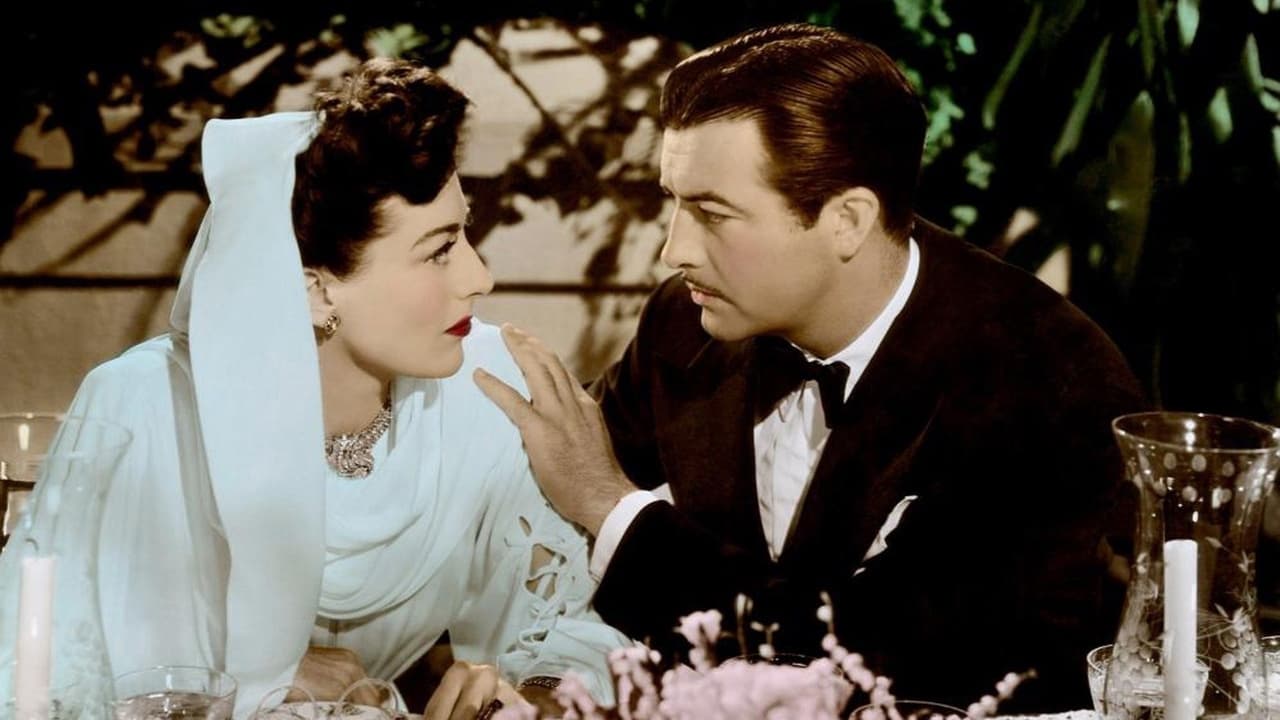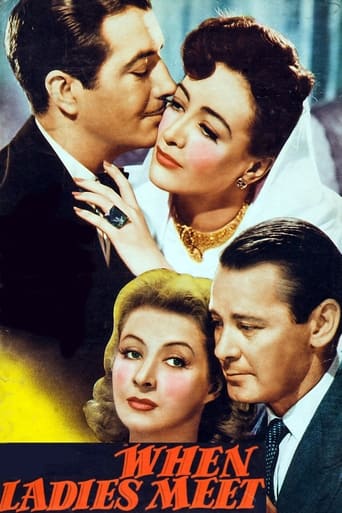StunnaKrypto
Self-important, over-dramatic, uninspired.
TaryBiggBall
It was OK. I don't see why everyone loves it so much. It wasn't very smart or deep or well-directed.
Quiet Muffin
This movie tries so hard to be funny, yet it falls flat every time. Just another example of recycled ideas repackaged with women in an attempt to appeal to a certain audience.
Skyler
Great movie. Not sure what people expected but I found it highly entertaining.
mark.waltz
The comparisons to Crawford's previous other women role in 1939's "The Women" will be many, but her character of Mary is as far from Crystal Allen as Green Garson's Claire is from Norma Shearer's overly noble Mary Haines. Novelist Crawford is in love with her publisher (Herbert Marshall) who is married to Garson, a witty woman who doesn't give any indication of why any man would cheat on her. Delightfully pleasant without being overly grand, Garson is an ideal wife, while Crawford incorrectly believes the wife she's never met (and knows nothing about) isn't exciting enough to care about. Thanks to Crawford's nosy admirer (Robert Taylor in a performance I found truly annoying), everybody ends up together at the country home of their dizzy friend, Spring Byington, where a friendly conversation between the two women brings everything out even though they have no idea of who the other one really is.It is the long conversation between Crawford and Garson that stands out in this light-hearted romantic drama with definite comic overtones where wife and girlfriend (Crawford is certainly more important to Marshall than just a mistress) bond, discover the truth and come to some conclusions. The men too learn a thing or two about the women they love, loathe or cheat on, so everybody manages to grow up a little.Rather dicey in the exploration of Byington's seemingly live-in relationship with a man she isn't married to. This is a rare example of how writers managed to get away with certain details that were overlooked by the very tough production code. Byington's dizzy Dora can be quite annoying at times, but ultimately you like her as well because she means well. Taylor, though, plays a truly meddlesome Lothario and the result, at least for me, was that I didn't want to see his character end up with anyone when everything comes out. It is Crawford and Garson who shine the most, their pairing obviously more congenial off-screen than Crawford's was with Shearer during the making of "The Women". The respect their characters have for each other during their introductory scenes shines through their admiration for each other personally.A bit livelier than the original 1933 version, it focuses more on the light-heartedness here than the Ann Harding/Myrna Loy pairing did with that version's Noel Coward like drawing room comedy. That version featured a more memorable performance by the hostess character (Faye Bainter) who didn't play her like a dumbbell. The country setting of Byington's old barn turned into a country home is the visual highlight of the film, with a huge waterwheel churning water into the man-made pool, shrubbery surrounding the house and pond, and a quaint interior which is truly a delight to explore. This weekend in the country would be a delight just for that.
rbrb
Entertaining flick, taken from a stage play.Writer is in love with her womanizer publisher who is already married.The writer's boy friend for his own motives sets the writer up to meet the publishers' wife with interesting consequences.The picture starts slowly but gets a up a head of steam and:I expected an explosive climax, but this is not that kind of film, nevertheless a clever story with an intelligent script.In my opinion the 2 male leads ought to have switched roles.In any event an enjoyable and watchable movie deserving:7/10
marcslope
Two MGM divas get to have at one another in a most civilized, clipped-consonant fashion in this remake of a livelier 1933 comedy-drama, adapted from a hit Rachel Crothers play. Joan Crawford is a best-selling authoress on the brink of an affair with her publisher, Herbert Marshall, who is married to Greer Garson; meantime, Robert Taylor pines, rather inexplicably, after Crawford. I'm sure Joan was an intelligent woman, but playing a New York smart-set intellectual (with a downtown apartment whose garden is the size of a city block), she's unable to project intelligence; you simply can't believe this clothes horse could come up with the smart one-liners Anita Loos puts into her mouth, or that she could pen anything more complex than "The Little Engine That Could." You sense that MGM is building up Greer as it tears down Joan; it's a much more sympathetic part, and though Greer doesn't enter the film till nearly the second half, she dominates it from there on. I find Greer's charms calculated and her acting style obvious, but she has the audience on her side and is more interesting to watch than the ever key-light-seeking Crawford. Why either should pine after the doughy, monotonous Marshall is never clear, and the fadeout is so plainly headed toward a conventional-morality-circa-1941 ending that the drama never runs very high. (For all that, it's resolved quickly and capriciously, and unconvincingly.) But Robert Taylor, at least, is relaxed and unaffected (especially compared to this diphthong-happy trio), and Spring Byington expertly indulges in a ditsy-rich-lady characterization you'd more likely expect from Billie Burke or Alice Brady (who, in fact, played the role in the 1933 version). The real star is the set designer -- I don't know about you, but I want that weekend house of Byington's, with its water wheel and clear lake and Better Homes and Gardens design.
Rastamon41
I bought this movie starring Joan Crawford, Greer Garson and Robert Taylor and the earlier version starring Myrna Loy, Robert Montgomery and Ann Harding. I have to say they should have used Myrna Loy rather than Joan Crawford in the new version, because Greer Garson stole the movie. Joan Crawford spent most of the earlier part of the movie fumbling with her exotic gown, in an attempt to draw attention to the gown and the person wearing it, which of course is Joan Crawford.If you get past Joan Crawford non-acting, and Herbert Marshall stiffness, then the movie is rather funny. Greer Garson and Robert Taylor carry this movie, if is rather funny, but I can't understand why any woman would prefer Herbert Marshall over the suave and good looking Robert Taylor. You ladies reading this review, please explain that to me. Even though I like this movie, I think the acting in earlier version was better especially Myrna Loy's acting. She is a better actress than Joan Crawford, at least in these two similar movies. This movie is a two woman in love with the same man Herbert Marshall (Rogers Woodruff), Greer Garson (Clare) is his wife, and Joan Crawford (Mary) is his lover. Why would these two beautiful women love this stiff man, I don't know, especially when they could both have Robert Taylor. Robert Taylor (Jimmy) is Joan Crawford's (Mary) old boyfriend, who realized that Herbert Marshall (Clare's husband, Rogers Woodruff) is not in love with Mary, he just wanted to sleep with her, he warns Mary, but she don't believe him, so he introduce Mary to Clare without telling Mary that Clare is Rogers Woodruf's wife, whom he Rogers Woodruff still loves. Once Mary finds out that Rogers Woodruff was lying to her, and only using her, she stated she is ashamed of her life and ashamed for sleeping with him, she also realized that the person who really loves her and really cares for her is Jimmy, you guess it. Jimmy finally gets her girlfriend back, who ends up being his wife, who will give him the six kids he wants, or maybe only two.

